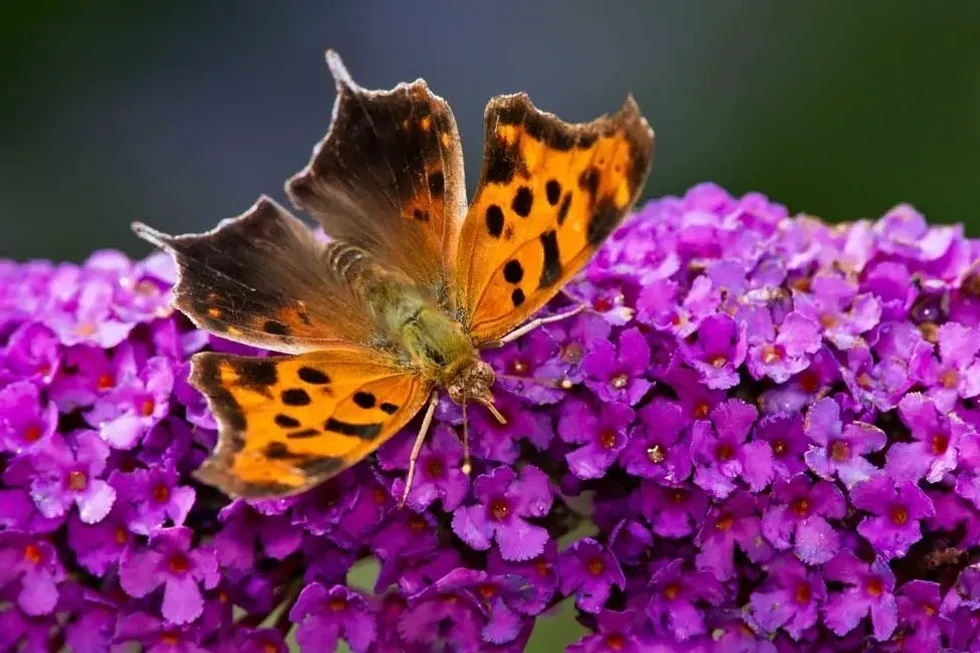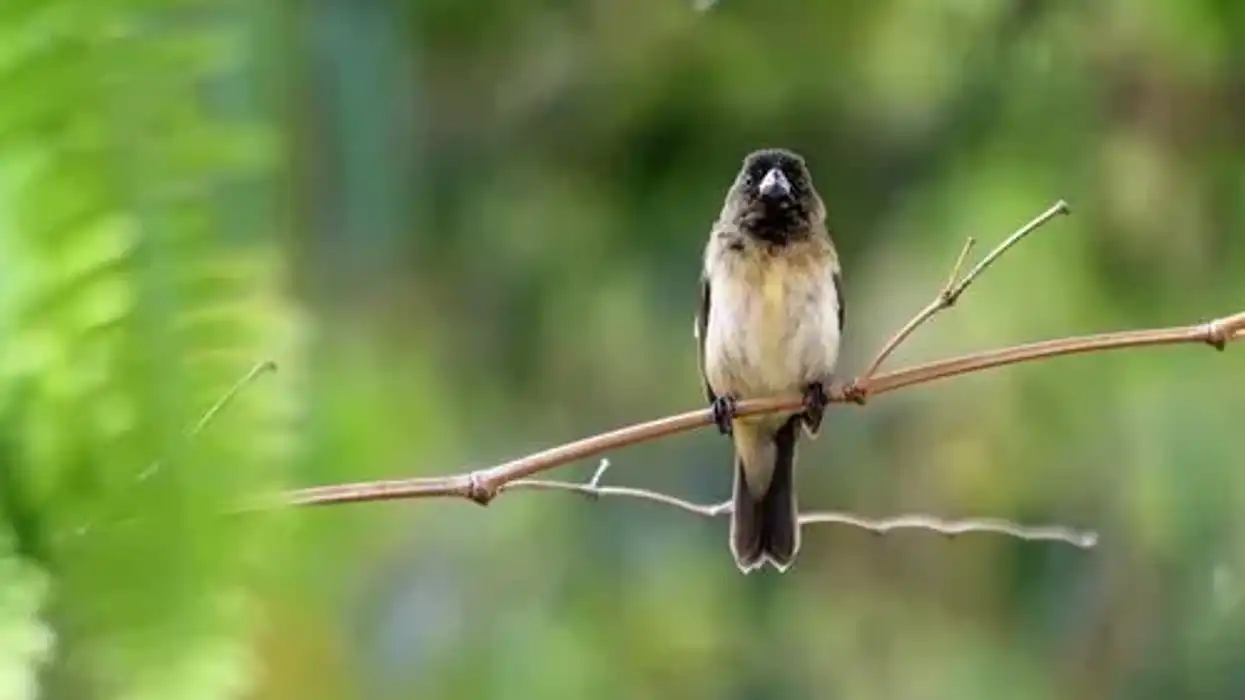The question mark (Polygonia interrogationis fabricius) butterfly belongs to the largest family of butterflies, the Nymphalidae family. The physical features of the question mark butterfly of the male and female are not different.
The question marks do not display sexual dimorphism, which is the difference in appearances due to the sexes. Both the male and female are of the same color, orange, with black spots on their hind wings and a dash of dark brown.
The common name, question mark butterfly Chrysalis, is given to this butterfly because of its appearance. The forewings of the adult question mark (Polygonia interrogationis fabricius) are hooked, making them look like a question mark at the end with vertical ridges.
Unlike the butterflies and moths of North America, the question mark butterfly is migratory as they migrate south every year, mostly in the winter or spring when the other species hibernate.
The question mark butterfly spiritual meaning is the same as the other butterflies and moths. These creatures indicate a very deep connection with the soul. They also symbolize spiritual rebirth and transformations.
We have lots more amazing facts and question mark butterfly info that everyone will enjoy. Let's look at these interesting facts. If you like these, then do read our purple emperor butterfly and morpho butterfly facts.
Question Mark Butterfly Interesting Facts
What type of animal is a question mark butterfly?
The question mark (Polygonia interrogationis fabricius) is a butterfly species of North America. The color of the adult butterfly is so good that they can easily camouflage themselves in the dead leaf matter and tree trunks.
What class of animal does a question mark butterfly belong to?
The question mark (Polygonia interrogationis fabricius) is the arthropod phylum that belongs to the class and family of Insecta and Nymphalidae, respectively.
How many question mark butterflies are there in the world?
The population of the question mark (Polygonia interrogationis fabricius) is secured in this world. Although the exact number is not calculated yet, they are in growth. Nature Serve also confirmed that the population of these dark brown and orange butterflies is secured, and they are living safe and sound with the other butterflies and moths of North America.
Where does a question mark butterfly live?
Like all the other butterflies, the question mark (Polygonia interrogationis fabricius) is also found near beautiful flowers for their sweet nectar, plants, and trees. The question mark butterfly is a native of the United States and is located in Canada and the whole of the United States except in New Jersey, Florida, and New York City.
What is a question mark butterfly's habitat?
The question mark (Polygonia interrogationis fabricius) habitat can be found in places with plants and trees, where these insects can feed on the sap and fruits of their host plant. They are also found in areas where there are several varieties of flowers and where they chase other insects and then feed on the nectar of flowers.
You can definitely find their habitat in woods, gardens, forests, and fields everywhere in the US except Florida, New York, and New Jersey.
Who do question mark butterflies live with?
The question mark (Polygonia interrogationis fabricius) butterflies are usually found in a group of the same type of butterflies. They build their nests near each other. Their nesting places are covered with dead leaf matter and are found on non-host plants.
How long does a question mark butterfly live?
The exact question mark butterfly life span range is not known as no appropriate study has been conducted to study the lifespan of the question mark butterfly. The adult butterfly can live up to the range of 6-20 days.
Usually, there are two different color forms of these butterflies. One is the question mark butterfly winter form where the hind wings are orange, and the other is the question mark butterfly summer form where the hind wings are black.
How do they reproduce?
The mating process of the question mark (Polygonia interrogationis fabricius) butterflies is the same as others. The adult male courts the female, and when the process is finished, the female builds the nest, and the eggs are laid on them.
They are laid in clusters of six to seven eggs at a time. The eggs are not laid on the host plant, including the American elm Ulmus, false nettle (Boehmeria cylindrica) Celtis, and hackberry Celtis.
The question mark butterfly egg then goes through the three stages after the eggs hatch: forming into larvae or caterpillars, then pupae, and finally into the adult butterfly. This is the usual question mark butterfly life cycle.
What is their conservation status?
The conservation status of the question mark (Polygonia interrogationis fabricius) butterflies is in the status of Least Concern. The lifespan of the adults is less than the other species, but they are still intact and safe.
The question mark butterfly Chrysalis has two color forms. One is the summer form where the hind wing in summer is in black while in the other one, in the winter form, their hind wing is orange every winter until they die.
Question Mark butterfly Fun Facts
What do question mark butterflies look like?
The question mark butterfly size is medium, around 3 in (7.62 cm) long, with orange and black wings with a brown underside. The upper wings are orange in color with little black spots, while the hind wings are black.
The wings are curved with short tips at the end. An adult question mark butterfly wingspan ranges from 1.8–3 in (4.5–7.6 cm).
How cute are they?
The question mark (Polygonia interrogationis fabricius) is a cute and beautiful butterfly. It is so pretty that once you look at it, it'll leave you in awe because of its unique and dandy shape. With its tiny spots, it'll leave you mesmerized.
How do they communicate?
The question mark (Polygonia interrogationis fabricius) communicates with the help of chemicals known as pheromones. Their wings also produce sounds as they flutter, which is another way for these beautiful insects to communicate with each other.
How big is a question mark butterfly?
The average size of a question mark (Polygonia interrogationis fabricius) butterfly is around 1.8-3 in (4.5-7.6 cm) length. The width of its wings is about 3 in (7.6 cm). These creatures are two to three times smaller than a blue morpho butterfly.
How fast can a question mark butterfly fly?
Like every other butterfly, the question mark (Polygonia interrogationis fabricius) can also fly 6.2-12.4 mph (10-20 kph). Their speed can vary as it all depends on how fast the wind flows, as their bodies are very lightweight.
How much does a question mark butterfly weigh?
The question mark (Polygonia interrogationis fabricius) is a very tiny and small insect. Its weight can be around 0.01 oz (0.3 g) in total.
What are the male and female names of the species?
There are no different names for the adult male and adult female question mark butterfly. They also do not display sexual dimorphism, so it is hard for the layman to tell them apart. They do not have gender-specific names.
What would you call a baby question mark butterfly?
The young question mark butterfly insects do not have a specific name but are often called question mark caterpillars or larvae after having hatched from eggs in the second stage. They are called pupae in the stage before becoming an adult butterfly. It all depends on the stage that which the young is in.
What do they eat?
The question mark butterflies feed on dead or rotten fruits, carrion, host plants, and the sap of trees. They can also feed on the nectar of flowers for the change of taste.
The young larvae and the caterpillars' diet consist of only the host plants, which they have to find independently.
The question mark butterfly host plants consist of false nettle (Boehmeria cylindrica), Celtis, American elm Ulmus, and the hackberry Celtis. The most favorite host plants of the caterpillars and larvae are the elm Ulmus plant as the elm Ulmus is a host plant that is soft to chew for the larvae and caterpillars.
Are they poisonous?
No, the question mark butterfly is not poisonous. There are short spines on the caterpillars to protect them. These spines can prick if you touch them with bare hands, but they cause no harm apart from this.
Would they make a good pet?
The question mark butterfly cannot be a good pet because of its short lifespan. These butterflies only last a few days. They are also migratory and hence would not make good pets. It would be best if you let them stay in the wild by themselves.
Did you know...
If we had to make the question mark butterfly vs comma butterfly comparison, you'd find that they look very similar. They both belong to the same species of butterflies, and they both have a punctuation mark in their names!
One difference is the black spots. On the question mark, they are placed in a curve. On the comma butterfly, they are placed in a straight line.
Another difference is that the hind wing of the question mark butterfly looks like a question mark, and the hind wing of the comma butterfly looks like a comma. The question mark butterfly is more common than the comma.
The question mark butterfly's silk is pink in color.
What attracts the question mark butterfly?
The question mark butterflies often consume nectar from rotting or overripe fruit. So to attract them, place decayed or rotten fruits like watermelons or strawberries in your open yard, especially near their host plants if you can, and then wait for them as they will come to smell them.
How long does a question mark butterfly caterpillar pupate for?
When the caterpillars of the question mark butterfly complete their last instar, they start to pupate. The next day, the caterpillar pupates into a brown Chrysalis with metallic spots on it, and it camouflages itself for few weeks until the adults are ready to emerge.
Here at Kidadl, we have carefully created lots of interesting family-friendly animal facts for everyone to discover! Learn more about some other arthropods from our puss moth facts and tube worm fun facts pages.
You can even occupy yourself at home by coloring in one of our free printable question mark butterfly coloring pages.










